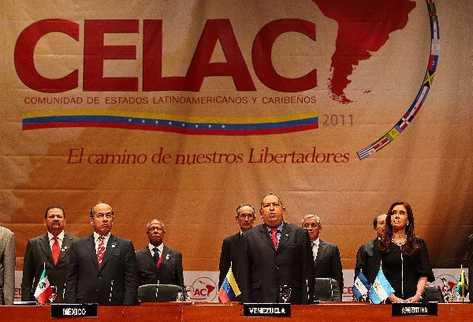Venezuelan president Hugo Chávez’s political skills were very much in evidence this past December 2 and 3 as the heads of 33 sovereign Latin American and Caribbean states signed on to a project that has long been dear to Chavez's heart. At the Teresa Carreño Theater in Caracas, Mexico’s Felipe Calderón, one of the genuine conservatives among Latin American leaders, opened the founding “presidential summit” of the Community of Latin American and Caribbean States (CELAC) with phrases the radical Venezuelan president has long championed.
 “Bolívar's idea is still in force and is common to us all Latin American and Caribbean peoples," Calderón told the assembled heads of state and government (with an occasional foreign minister sitting in for his or her boss). "I am convinced: This is the hour and this is the decade of Latin America, and we have to step up the pace toward integration.” It was in Calderón’s Mexico that the idea was generated at a preparatory meeting some 22 months ago: an integrated community of 33 countries, all the sovereign states of the Americas except the United States and Canada.
“Bolívar's idea is still in force and is common to us all Latin American and Caribbean peoples," Calderón told the assembled heads of state and government (with an occasional foreign minister sitting in for his or her boss). "I am convinced: This is the hour and this is the decade of Latin America, and we have to step up the pace toward integration.” It was in Calderón’s Mexico that the idea was generated at a preparatory meeting some 22 months ago: an integrated community of 33 countries, all the sovereign states of the Americas except the United States and Canada.
In contemporary Latin America and the Caribbean there are political projects that pit class against class, sector against sector, country against country, but there are also projects that—for now, at least—resonate across the board. It took Chávez’s skill (and oil revenues) to bring together a broad swath of leaders who disagree about many things, but for whom the idea of regional sovereignty and autonomy resonate powerfully. It took Calderón’s understanding of the importance of the issue to overcome his ideological hostility to Chávez and the “pink tide”—which he has demonized in Mexico—to bring him to Caracas and to legitimize the project among the region’s center-right leaders.
A common colonial history to the side, careful and cautious steps toward economic and political integration make a good deal of sense for the region. Among other things, carefully crafted integration would give the combined countries of Latin America and the Caribbean a greatly expanded internal market, a stronger position from which to negotiate with the International Financial Institutions (the IMF, World Bank, etc.), controlled by the United States and Europe, and with other regional blocs of “developing” countries. It would also offer the region's countries a much larger pool of internal investment capital with which to compete with foreign-based transnational investors. With an eye toward the financial crisis in Europe, a CELAC “action plan” calls for the new group to develop mechanisms to “strengthen and deepen the integration of our economies” in order to minimize the fallout of a possible European collapse. The institutions of integration have only just begun to be crafted, but now it is clear that across ideological borders, the political will—if not yet the institutional structure—is there.
Calderón’s presence showed that there is no necessary contradiction between a free-trade economic policy and regional integration—even of a horizontal sort. Since Calderón took office, Mexico’s economic policy has been under the guidance of neoliberal economist Augustín Carstens, a one-time candidate to the presidency of the IMF. Nonetheless, some of the old neo-Keynesian policies of import-substitution industrialization (though not under that name), a subsequent expansion of the internal market and demand-driven growth have found favor in otherwise conservative policy circles.
Meanwhile, until more permanent structures are negotiated and established, the group will have no permanent, institutional home. Its home will be wherever negotiations are taking place. It will have a rotating leadership consisting (formally) of the heads of state or government of three countries: the country hosting the current presidential summit, the country that hosted the previous summit, and the country that will host the summit scheduled for next year. Its future is unwritten.
For more from Fred Rosen's blog, "Mexico, Bewildered and Contested," visit nacla.org/blog/mexico-bewildered-contested.
For more on CELAC, check out the following articles from around the web:
-Federico Fuentes, “Summit in Venezuela Opens ‘New Phase in History,’ ” Green Left Weekly, December 3, 2011.
-Alex Main, “CELAC: Speaking for Latin America and the Caribbean,” CEPR, December 6, 2011
-Tamara Pearson, “Latin America no Longer for Sale: the New CELAC Poles Apart From the OAS,” Venezuelanalysis.com, December 7, 2011
-Eva Golinger, “A Union Is Born: Latin America in Revolution,” Postcards From the Revolution, December 8, 2011.

